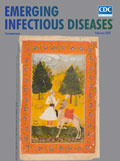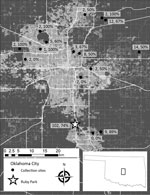
Volume 26, Number 2—February 2020
Research Letter
Rickettsia parkeri and Candidatus Rickettsia andeanae in Amblyomma maculatum Group Ticks
On This Page
Figures
Downloads
Article Metrics
Abstract
We determined prevalence of Rickettsia spp. in 172 ticks of the Amblyomma maculatum group collected from 16 urban sites in Oklahoma City, Oklahoma, USA, during 2017 and 2018. Most ticks (59.3%) were collected from 1 site; 4 (2.3%) were infected with Rickettsia parkeri and 118 (68.6%) with Candidatus Rickettsia andeanae.
Rickettsia parkeri, part of the spotted fever group Rickettsia (SFGR), affects humans throughout much of the southern United States (1). Although R. parkeri in an engorged nymph was reported once in Oklahoma, R. parkeri has not been reported in adult A. maculatum ticks in Oklahoma or Kansas. To date, all test-positive adult ticks in Kansas and Oklahoma have been infected with Candidatus Rickettsia andeanae (2). The absence of R. parkeri in Oklahoma is surprising because it was detected in A. maculatum group ticks recovered from dogs in Arkansas counties bordering eastern Oklahoma (3) and in adult A. maculatum ticks in Texas (4), and A. maculatum ticks have been present in Oklahoma since the 1940s (4). We collected A. maculatum ticks in the Oklahoma City metropolitan area during May–August 2017 and 2018 and tested them for Rickettsia spp.
We selected 16 sites as part of a larger study of tickborne disease epidemiology (Figure). We performed collections during May–August by flagging vegetation or using CO2 traps (5). We completed identification by using established keys (6).
We tested field-collected ticks for rickettsial DNA by using established PCR protocols (7,8). To limit DNA contamination, we conducted DNA extractions by using site-specific reagents in a separate laboratory. After soaking adult ticks in deionized water for 30 minutes and surface-sterilizing with 70% ethanol, we longitudinally bisected ticks; we used one half for DNA extraction and stored the other half at −80°C. DNA extraction followed established protocols (5). In 2017, we screened all ticks by using assays targeting the gltA and ompA (8) genes and retested positive samples by using an assay targeting the ompB gene (primer pair 120–2788/120–3599) (7). In 2018, we initially screened ticks by using the gltA assay and confirmed the results with an ompB assay.
We sequenced positive ompB amplicons bidirectionally by using an Applied Biosystems 3730 DNA Analyzer () at the Oklahoma State University Core Facility to identify bacterial species. We verified each resulting sequence by using BioEdit 7.2 () and aligned bidirectional sequences to create consensus sequences by using Clustal Omega (). We compared resulting consensus sequences with GenBank submissions by using default conditions on BLAST (), using the highest percentage sequence identity to determine species similarity.
We collected 172 adult ticks in the A. maculatum group (112 in 2017, 60 in 2018; 81 male [50 in 2017, 31 in 2018] and 91 female [62 in 2017, 29 in 2018]) from 15/16 sites across Oklahoma City (Figure). Most (59.3%) A. maculatum ticks were collected at 1 site in the southwestern metropolitan area consisting of grassland and deciduous shrubland and woodland surrounded by rapidly growing suburban developments (Figure). Most A. maculatum tick collections occurred in areas dominated by grassland with few woody plants and trees.
Initial screening of the 172 ticks detected 122 positive results, indicating a Rickettsia spp. prevalence of 70.9% (76.8% in 2017, 60.0% in 2018). Consensus sequences demonstrating 100% identity with the 850-bp portion of the ompB gene of R. parkeri Portsmouth (GenBank accession no. CP003341.1) and the 590-bp portion of the ompA gene of R. parkeri La Paloma (GenBank accession no. MG574938.1) were amplified from 4 (3.3%) positive A. maculatum ticks (3 males in 2017, 1 female in 2018). All 4 R. parkeri–infected ticks were from 1 site (Figure). The remaining 118 (96.7%) sequences from 122 amplicon-positive A. maculatum ticks demonstrated complete identity to homologous 850 bp portions of the ompB gene of Candidatus R. andeanae (GenBank accession no. GU395297.1). The overall Candidatus R. andeanae prevalence by sex was 72.8% for males (74% in 2017, 71% in 2018) and 64.8% for females (74.2% in 2017, 44.8% in 2018). Most Candidatus R. andeanae–infected ticks (74/118) were from the park with R. parkeri–positive ticks; however, Candidatus R. andeanae–positive ticks also were collected in 12 other sites (Figure). No dually infected ticks were identified.
We identified A. maculatum group ticks infected with R. parkeri and Candidatus R. andeanae in the Oklahoma City metropolitan area. Oklahoma lies at the western edge of 1 of the highest-incidence areas of SFGR in the United States (1). To date, no human rickettsiosis cases caused by R. parkeri have been reported in Oklahoma, possibly because of treatment based on nonspecific symptoms and the lifting of mandatory reporting to the Centers for Disease Control and Prevention (9). The low prevalence of R. parkeri in Oklahoma ticks differs from other areas of the United States, such as Virginia, where prevalence of R. parkeri is higher in A. maculatum ticks (10). Candidatus R. andeanae prevalence in A. maculatum ticks varies inversely with R. parkeri prevalence in some regions (4). Although Candidatus R. andeanae is not known to cause human illness (4), the high prevalence of Candidatus R. andeanae in Oklahoma ticks might interfere with R. parkeri development, limiting its distribution (2). The potential presence of this human pathogen in the largest metropolitan area in the state, and 1 of the largest in the central United States, necessitates thorough case evaluation of future SFGR cases in this region.
Dr. Noden is an associate professor of medical and veterinary entomology in the Department of Entomology and Plant Pathology at Oklahoma State University. His research interests include vectorborne diseases involving ticks, mosquitoes, and fleas.
Acknowledgments
We would like to thank Dawn Brown, Caitlin Laughlin, Caleb McKinney, and Liam Whiteman for invaluable help with tick collections. We also thank William Nicholson for providing the positive control R. rickettsii DNA.
This work was supported through the Oklahoma Center for the Advancement of Science and Technology (grant no. HR16-038) and US Department of Agriculture National Institute of Food and Agriculture Hatch funds through the Oklahoma Agricultural Experiment Station (grant nos. OKL-03085 and OKL-02915).
References
- Drexler NA, Dahlgren FS, Heitman KN, Massung RF, Paddock CD, Behravesh CB. National surveillance of spotted fever group rickettsioses in the United States, 2008–2012. Am J Trop Med Hyg. 2016;94:26–34.
- Paddock CD, Denison AM, Dryden MW, Noden BH, Lash RR, Abdelghani SS, et al. High prevalence of “Candidatus Rickettsia andeanae” and apparent exclusion of Rickettsia parkeri in adult Amblyomma maculatum (Acari: Ixodidae) from Kansas and Oklahoma. Ticks Tick Borne Dis. 2015;6:297–302.
- Trout R, Steelman CD, Szalanski AL, Williamson PC. Rickettsiae in Gulf Coast ticks, Arkansas, USA. Emerg Infect Dis. 2010;16:830–2.
- Paddock CD, Goddard J. The evolving medical and veterinary importance of the Gulf Coast tick (Acari: Ixodidae). J Med Entomol. 2015;52:230–52.
- Noden BH, Loss SR, Maichak C, Williams F. Risk of encountering ticks and tick-borne pathogens in a rapidly growing metropolitan area in the U.S. Great Plains. Ticks Tick Borne Dis. 2017;8:119–24.
- Keirans JE, Litwak TR. Pictorial key to the adults of hard ticks, family Ixodidae (Ixodida: Ixodoidea), east of the Mississippi River. J Med Entomol. 1989;26:435–48.
- Roux V, Raoult D. Phylogenetic analysis of members of the genus Rickettsia using the gene encoding the outer-membrane protein rOmpB (ompB). Int J Syst Evol Microbiol. 2000;50:1449–55.
- Labruna MB, McBride JW, Bouyer DH, Camargo LMA, Camargo EP, Walker DH. Molecular evidence for a spotted fever group Rickettsia species in the tick Amblyomma longirostre in Brazil. J Med Entomol. 2004;41:533–7.
- Biggs HM, Behravesh CB, Bradley KK, Dahlgren FS, Drexler NA, Dumler JS, et al. Diagnosis and management of tickborne rickettsial diseases: Rocky Mountain Spotted Fever and other spotted fever group rickettsioses, ehrlichioses, and anaplasmosis—United States. MMWR Recomm Rep. 2016;65:1–44.
- Nadolny RM, Wright CL, Sonenshine DE, Hynes WL, Gaff HD. Ticks and spotted fever group rickettsiae of southeastern Virginia. Ticks Tick Borne Dis. 2014;5:53–7.
Figure
Cite This ArticleOriginal Publication Date: 1/15/2020






















.png)












No hay comentarios:
Publicar un comentario